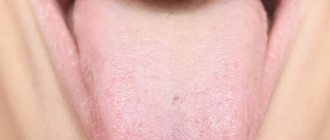What color should the tongue normally be?
Keep in mind! Such an unremarkable organ as the tongue performs a number of important functions:
- Articulation is responsible for the ability to pronounce sounds.
- Eating food - chewing, moving a bolus of food around the mouth, swallowing.
- Recognition of tastes - the sensation of sour, salty, sweet and bitter.
- Regulation of local immunity with the help of the tonsil in the mucous tissue of the root of the tongue.
Light, whitish deposits on the lingual surface are a type of normal .
You should know! They are a layer of keratinized epithelium (dead tissue from thread-like taste buds).
The tongue of a healthy child from 3 to 7 years old should meet the following characteristics:
- Color and structure . The surface is pink, soft, with a smooth groove in the center and visible tubercles of taste buds.
- Raid . A small amount of whitish plaque on the back is acceptable. It can be easily and painlessly removed with a toothbrush or cotton pad.
- Feel . The organ does not hurt, has no swelling or irregularities, and does not interfere with articulation and swallowing.
- Smell . Normally, there is no bad breath.
Important! To avoid possible problems with the oral cavity, teach your child to also clean the tongue surface while brushing his teeth.
This can be done either with a regular toothbrush or with a special scraper spoon.
What is plaque on the tissues of the tongue?
We will divide the reasons for the formation of layering into groups:
- anatomical;
- hygienic:
- medicinal.
The tongue as an anatomical organ of a person is unique in that its mucous membrane is covered with an epithelial cover with formations in the form of papillae. They help us taste food. They are also easily susceptible to the destructive effects of microbes and bacteria. Therefore, epithelial cells become obsolete, peel off, replacing themselves with young cells. But it happens that this process is inhibited by the upper layers of the epithelial membrane, which, during the active change of cells, die, but do not crumble, forming a coating on the tongue.
The cause of plaque is the use of strong antibiotics
Why it appears: reasons
The reasons for the formation of brown deposits on the surface of this organ in a child are in many ways similar to the reasons for its appearance in an adult.
However, there are a couple of exceptions due to bad habits.
In adults, the coating on the tongue may become darker due to the abuse of caffeine and cigarettes, which is natural - not applicable to the baby.
In most cases, the coloring of this sensory organ in shades from red to brown is associated with disorders of the gastrointestinal tract.
Note! At the same time, the intensity of the color is directly proportional to the complexity and severity of the disease.
Other reasons include : _
- Diseases of the respiratory system (lungs, bronchi). Deposits appear in the morning after waking up, and after cleaning the oral cavity they appear again.
- Treatment with dyes or antibiotics. On some medicines (Faringosept, Malavit, etc.), the manufacturer himself indicates the likelihood of the appearance of colored plaque as the norm. As a rule, at the end of therapy, the tongue surface acquires its usual, healthy appearance.
- Food poisoning, dysbacteriosis . In this case, the formations are accompanied by a bitter taste, diarrhea or constipation, as well as pain in the lower abdomen. The unhealthy color will disappear only after the underlying disease is eliminated.
- Fungal infection of the mucous membrane (tissue microsis). The disease is characterized by thickening and then darkening of the natural plaque. Without proper treatment, the color will become more and more saturated.
- Dehydration of the body. Most often it is a consequence of disorders of the gastrointestinal tract. To solve the problem, you need to consult with a pediatrician on the selection of medications and provide the body with sufficient fluid.
Stay up to date! Sometimes a brown coating on the tongue may appear due to the consumption of chocolate, cocoa, Coca-Cola and other coloring products.
Causes of brown plaque on the tongue
So, the appearance of masses on a muscle organ of an unnatural color is an alarming symptom. There are different reasons for the appearance of brown plaque. Moreover, they can be both serious and superficial, which can be easily eliminated.
- Excessive consumption of chocolate and coffee leaves its mark. True, this problem is easily solved; such a layering does not pose a threat. It is enough to balance the coloring product and clean your mouth regularly.
- Such deposits are typical for people who are addicted to alcoholic beverages and cigarettes. Inhalation of resins not only forms plaque, but also the appearance of stones on the crowns, which causes dental caries.
- The appearance of the film is also provoked by such serious factors as lung disease, joint inflammation, blood disease, problems with the adrenal glands and the endocrine system.
And the list of reasons goes on.
In the morning
To correctly determine the provoking aspect of an unpleasant phenomenon, you should pay attention to the time at which it appears. Normally, in the morning, a light and transparent film may be present on the muscle organ. After hygiene procedures it disappears. Dark deposits are a sign of problems in the body. They are constantly detected, after cleaning they disappear for a short time and appear again.
If the sticky masses are intensely colored in the morning, it is possible that the digestive system or airways are not functioning properly. In the first case, the deposits are located on the back wall of the tongue, and in the second - on the tip. If the accumulations do not even partially disappear after cleaning or eating, you should suspect chronic diseases. Remember, the presence of deposits for three days or more requires a visit to the doctor so as not to miss the intoxication of the body.
Stomatitis
Light brown plaque may indicate progressive stomatitis.
- Initially the deposits are white. But, if the patient ignores the therapy, the film acquires a brownish tint.
- The mucous membranes of the mouth are painful, especially when removing accumulations.
- Ulcers form in the mouth and tongue. Discomfort increases when the disease is advanced.
Gastrointestinal diseases
A dark brown coating on the tongue most often indicates problems with the gastrointestinal tract. This is the reaction of the receptor system to the presence of pathology of the intestines or stomach, pancreas or gall bladder.
- Fibrous or corrosive gastritis.
- Inflammation of the small intestine (enterocolitis) or large intestine.
- Ulcerative diseases.
- Dysbacteriosis or reflux.
- Pancreatitis or diarrhea.
- Hepatitis or cholecystitis.
- Duodenitis or biliary dyskinesia.
In such cases, treatment of the underlying disease and comprehensive cleaning of the oral cavity are needed. If treatment is carried out in a timely manner, complications are excluded.
Fungal diseases
A very common provoking factor for deposits on the muscular organ is progressive oral candidiasis. When the mucous membranes are affected by mycosis (fungus), at an early stage the film has a whitish color. It is difficult to remove. If left untreated, the lesions begin to darken. In advanced stages, erosive foci form, which are located in the central part of the muscular organ. A white-brown coating obliges the patient to immediately visit a doctor. Only he can establish the true cause of the disease and develop a treatment program.
Taking antibiotics and other medications
Taking certain medications also causes brown deposits on the tongue.
- Such side effects are often diagnosed after antibiotics. The accumulations may disappear on their own when the therapeutic course ends.
- It happens that deposits are a consequence of drug abuse.
- The color of the muscular organ often changes after taking pharyngosept.
- A brown tongue provokes malavit.
Before starting therapy, be sure to read the instructions. If this is a side effect of the medication, the problem will go away after a course of therapy.
B vitamin deficiency and weakened immunity
Another cause of dark deposits is hypovitaminosis, which leads to a decline in the immune system. Lack of vitamins PP and B, as well as iron, negatively affects oral health. Sometimes a disease such as pellagra occurs, which is caused by a deficiency of nicotinic acid. Vitamin deficiency causes both a gray-brown coating and the appearance of painful cracks and a “varnished” tongue. Regardless of the reason, careful oral hygiene is mandatory. The tongue is cleaned daily with a special toothbrush.
Features of consistency and thickness of plaque
In order not to lose sight of the onset of any serious disease, it is necessary to regularly examine the baby’s oral cavity.
At the same time, you should pay attention not only to the presence of plaque, but also to its consistency, location and thickness .
Your observations will make the pediatrician’s work easier in making a diagnosis.
As a result of many years of medical observations, it was possible to establish the following relationship between plaque on the tongue and the condition of the human body:
- A thin/spotty coating on the tip of the tongue indicates diseases of the heart muscle and respiratory system.
- A thick layer of brown deposits on the root indicates intestinal pathologies.
- A brown stripe in the center of the tongue can be a “signal for help” from the spleen, gall bladder or liver.
Important! Do not try to make a diagnosis and prescribe treatment yourself - this can be dangerous for the baby’s health. Only a doctor can determine the true root cause of the disease.
Brown coating on the tongue in children
In childhood, deposits on a muscle organ can be diagnosed for various reasons.
- For example, dental problems. In such a situation, dental treatment should be entrusted to an experienced dentist.
- However, the tongue becomes covered with accumulations as a result of consuming coloring products, especially those with chemical additives. In infants, this often happens from the introduction of new complementary foods. Therefore, if your tongue turns from soft pink to brown, change your diet.
- A slight brown coating on a child’s tongue is also observed during ARVI. Hygiene and quality nutrition will help get rid of this unpleasant phenomenon.
- Schoolchildren may suffer from congestion due to bronchitis and incipient pneumonia, as well as gastrointestinal problems.
In any situation, parents should show their child to a pediatrician. If necessary, the baby is referred to a gastroenterologist, endocrinologist, infectious disease specialist and other specialists. After examination and diagnosis, adequate therapy is prescribed.
How is diagnosis carried out?
An accurate diagnosis is established only after a series of the following medical examinations:
- General blood analysis;
- Blood biochemistry;
- Antibody test;
- Scraping from the surface of the tongue;
- Stool and urine analysis.
In some cases , an ultrasound examination of the stomach, intestines or respiratory tract may be required .
Need to know! Depending on the results found, the pediatrician may give a referral to other doctors: a gastroenterologist, an infectious disease specialist, a toxicologist, or a dentist.
Possible treatment
Treatment of brown plaque involves eliminating the root cause , since it is not a separate disease, but only a symptom of the underlying disease.
Only a doctor can make a correct diagnosis and prescribe treatment.
In most cases, he prescribes antibiotics and medications to regulate the functioning of the gastrointestinal tract .
If the course of treatment is successful, the brown plaque disappears on its own.










